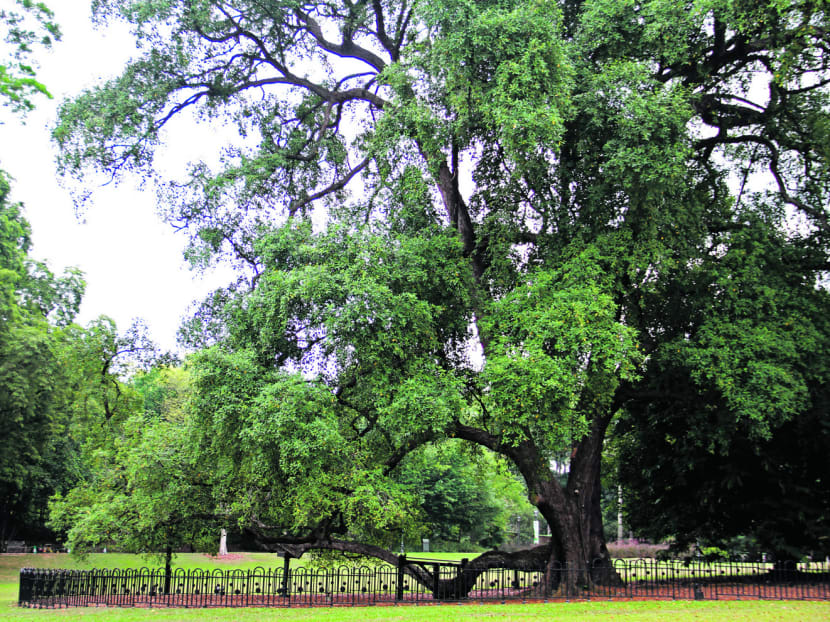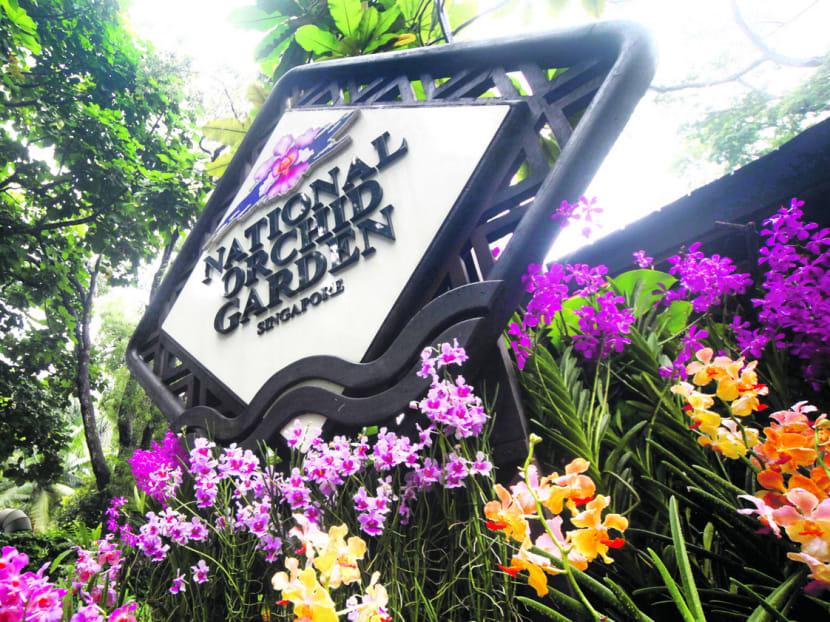UNESCO bid dossier a labour of love since 2010
BONN — When Ms Jean Wee, the director of National Heritage Board’s (NHB) preservation of sites and monuments division, was tasked to study Kew Gardens’ UNESCO nomination dossier in preparation for Singapore Botanic Gardens’ own bid, she felt discouraged.


BONN — When Ms Jean Wee, the director of National Heritage Board’s (NHB) preservation of sites and monuments division, was tasked to study Kew Gardens’ UNESCO nomination dossier in preparation for Singapore Botanic Gardens’ own bid, she felt discouraged.
Describing the gardens in the United Kingdom as the “mothership” of satellite British colonial-styled gardens, Ms Wee said it possessed outstanding structures and monuments, and unique features.
“Looking at (the aspect) of ‘human interchange’, I thought, ‘Good grief, they were miles ahead of us!’,” she said. “We know Kew is different from (the Botanic Gardens); you cannot compare oranges with apples. But it is so outstanding on that level (and) we have to somehow reach that and be on par with them.”
But after spending one-and-a-half years compiling and writing up the Singapore Botanic Gardens’ nomination dossier, Ms Wee felt confident enough to check the recommendation of the International Council on Monuments and Sites (ICOMOS) — released past midnight on May 16 — only the morning after. The non-governmental organisation’s recommendation to the UNESCO World Heritage Committee is part of the bid process — it backed the inscription without reservation, the best recommendation possible.
The 156-year-old Singapore Botanic Gardens became the Republic’s first UNESCO site last Saturday — the culmination of preparation work set around a tight timeline since 2010, said Ms Wee.
The first thing she did was to create a timetable of all the deadlines she had to meet such that the Gardens’ possible inscription would be in time for Singapore’s Golden Jubilee celebrations.
The year 2012, in particular, was crunch time because Singapore had yet to sign the United Nations’ 1972 Convention for the Protection of the World Cultural and Natural Heritage to allow it to nominate the Botanic Gardens for UNESCO inscription.
Working with just two contracted staff, Ms Wee said the NHB’s role at the beginning was “more administrative”, where they had to secure the budget and sign-offs from the Minister for Culture, Community and Youth, for instance. Consultations were held with government stakeholders, such as the Singapore Land Authority and the Urban Redevelopment Authority, to ensure government support for protecting the Gardens’ buffer zone from future development.
PUTTING THE DOSSIER TOGETHER
Research for the dossier began at least three years ago, around the time Dr Nigel Taylor arrived in Singapore to become the director of the Singapore Botanic Gardens — he was brought in specifically because he had participated in the UNESCO bid for the Royal Botanic Gardens, Kew, between 2000 and 2003.
Putting the dossier together involved staff, past and present, of the National Parks Board (NParks), such as the Botanic Gardens’ long-time librarian Christina Soh, 60, who made two trips to the Kew Gardens in August 2011 and February 2012 to fill in the missing information in the Singapore Botanic Gardens’ history. For weeks, she also pored over boxes of archive materials and found photos and correspondence from the Gardens’ directors in the mid-1800s.
To research the history and architecture of the Gardens, individuals, groups and academics were roped in, Dr Taylor said. Associate Professor Timothy Barnard from the National University of Singapore, for instance, got his students to do individual research projects that looked into elements of the Gardens’ history.
And these students came up with interesting anecdotes that Dr Taylor said he would not have uncovered, including stories about how the former superintendent at the Gardens had his life threatened by staff he had problems with. “Those sort of things don’t get into annual reports because they are like the dirty linen no one wants publicised. But they are very important in understanding the history of the place,” added Dr Taylor.
ICOMOS Singapore helped with the research on the social and physical history of the gardens, said its president Kevin Tan, a law professor.
Over two months, the team, which included architecture historians and conservators, as well as an archaeologist, studied the Gardens’ physical structures and the socio-history of the place, such as the music performances that were held right through the Japanese Occupation.
Public engagement sessions were also held with the Gardens’ stakeholders, such as heritage and environment groups, volunteers and members of the public, apart from consultations with previous directors of the Gardens and the first commissioner of Parks and Recreation Wong Yew Kwan, he added.
To draw up a site management plan for the Gardens, they worked with a British consultant to look into the commonly-encountered operational procedures and issues to put up a list of recommendations, Commissioner of Parks and Recreation in NParks Leong Chee Chiew said.
Beyond the gathering of information, Dr Taylor said his team at NParks also had be trained to talk about the heritage of the Singapore Botanic Gardens so as to market it to the World Heritage Committee members, their ambassadors as well as other international heritage experts.
“You need to raise awareness with everybody, not just the people who may be close to the decision-making process,” he added.
After going through at least seven drafts over one-and-a-half years, the 700-page nomination dossier, was eventually completed in 2013.
Out of a “kiasu” mentality, Ms Wee revealed, they sent a draft nomination dossier to UNESCO in 2013 to check for completeness, before the official submission in January last year.
Dr Taylor, on the other hand, was always quietly confident of the Botanic Gardens’ bid. “I did all these 15 years ago and I could see that even though the Singapore Botanic Gardens is much smaller (than) the Royal Botanic Gardens, Kew, it had a key place in history ... I can see that from the beginning and it’s probably harder for others to see,” he added.
CONVINCING SINGAPOREANS AND THE WORLD
Although she tried to avoid any near-misses by sticking to set deadlines — the nomination dossier was submitted two weeks before the deadline — Ms Wee said there were still minor glitches along the way.
For example, photos to be used in the report did not come in by the cut-off dates, she said. When the nomination dossier was sent for printing, the printing firm called to inform them that its machine was faulty and printed only 400 pages of the report. Even when the nomination dossier was finally ready for delivery, the courier service failed to pick it up from their office that evening, added Ms Wee.
“But we are in the business of putting up exhibitions as well, so we’re used to whatever that can go wrong will go wrong and we just have to find a way to deal with it,” she said.
On the international front, Singapore’s ambassador and permanent delegate to UNESCO Andrew Toh said the Ministry of Foreign Affairs’ role was to ensure that any document Singapore presents, such as the nomination dossier, is accepted in the context it was intended for.
While the gardens is usually seen as a natural landscape site, its nomination was for a cultural site and the Gardens’ cultural aspects were not easy to convey to others, he said.
Submitting the document to UNESCO was not the end of their work. Ms Wee said the NHB and NParks continued with promotional work to build up awareness of the Gardens’ heritage value among Singaporeans and convince them that the Gardens was worthy of the international accolade.
Recounting Singaporeans’ early remarks on the bid, she said: “Singaporeans say, ‘What, you mean Singapore Botanic Gardens can make it?’ ... ‘It’s a park, my goodness, why do you say it’s a world heritage site?’”
So they put up exhibitions in shopping malls explaining how the Gardens qualifies as a world heritage site, offering prizes for quizzes on the bid, among other activities to get Singaporeans involved.
Acknowledging that it is a challenge convincing Singaporeans, Ms Wee said many remain unaware of the Singapore Botanic Gardens’ history.
“I think people have taken (the Botanic Gardens) for granted over the years. They think it’s a place to do yoga ... to jump on that Tembusu tree or maybe in the past you feed the swans in the lake. But where is the cultural aspect?” she said.
REAPING WHAT THEY SOWED
After five years of planning and preparation, the moments before the results of Singapore Botanic Gardens’ bid to become a UNESCO World Heritage Site sparked many thoughts in her mind, said Ms Wee.
“Firstly, the moment we had always hoped for was finally about to happen. And on the other hand, I wanted to pay attention to the comments made by the state party members when the floor was opened to them,” she said.
On the congratulatory messages from the World Heritage Committee members, Dr Taylor said: “It was extraordinary, one of the longest salutations I’ve heard ... and every single member of the committee had something important to say and some had a lot to say in favour of the inscription.”
Looking back, Mr Toh said it felt like he had been taken on an emotional roller coaster for the past 18 months. “Like all projects, there are days where you feel reasonably confident, there are days where you feel maybe you’re over-confident, so you have these ups and downs,” he said.
Recalling his initial doubts, Mr Toh said he experienced a little bit of the Singaporean “kiasu” mentality, thinking he could have done better at times. But he added: “It’s obvious that a lot of the downsides were misplaced.”






